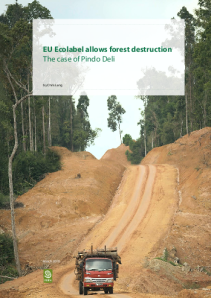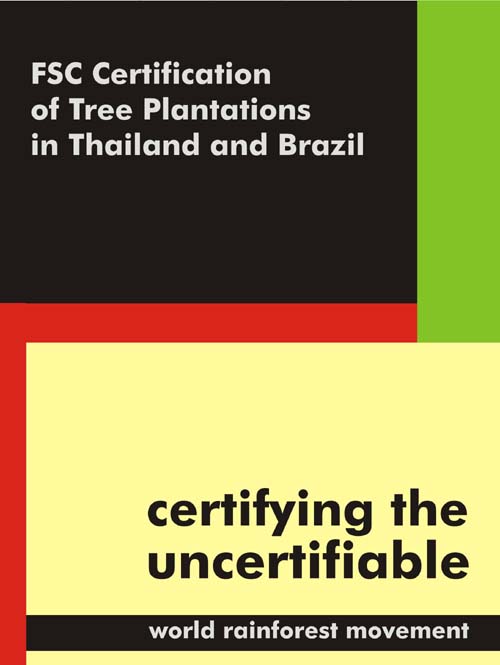Why does the UN’s latest scheme to save the forests not address the drivers of deforestation?
By Chris Lang. Published in WRM Bulletin 145, August 2009.
Forests are big news these days. Preventing deforestation will help us address climate change (at least if the carbon stored in the forests isn’t traded, allowing emissions to continue elsewhere).[1] Yet forests have never been under such serious threat.
Reducing deforestation is a good idea. Stopping it altogether would be better. Paying the Indigenous People and local communities who protect the forests would be even better. That is supposed to be the idea behind the Big New Plan to save the forests: REDD (reducing emissions from deforestation and forest degradation). So why does REDD not attempt to address the drivers of deforestation?
As WRM has repeatedly pointed out, one of the most insidious threats to forests comes from industrial tree plantations. The current obsession with all things carbon, coupled with the UN’s failure to differentiate between forests and plantations,[2] provides the biggest ever incentive to clear forests and replace them with plantations.
A major part of that threat comes from a false solution to climate change: biomass plantations. According to the Intergovernmental Panel on Climate Change wood is considered to be “biogenic carbon”, which is “part of the natural carbon balance [that] will not add to atmospheric concentrations of carbon dioxide.” But as a result of this creative accounting, biomass plants are springing up like mushrooms after the rain. China is planning to build 30,000 MW of biomass power plants by 2020. The southern USA has been called the “Saudi Arabia of biomass”. Much of this expansion is to feed European utility companies, which have to produce 20 per cent of their energy from “renewable sources” by 2020.[3]
As trees grow they absorb carbon. So far so good. But biomass proponents are ignoring the fact that burning wood releases carbon dioxide, much as the pulp and paper industry ignores the fact that pulping wood to make paper also produces massive amounts of carbon dioxide.
Of course, if the trees are replanted, they will absorb carbon dioxide. But even with the fastest growing eucalyptus trees there is a five to seven year delay before the carbon dioxide released by burning the wood is absorbed by the trees. If we are going to address dangerous runaway climate change, the last thing we need is a five to seven year delay. Trees in Europe and the USA grow more slowly and therefore take longer to absorb the carbon.[4]
A May 2009 report in Science magazine, written by Marshall Wise and colleagues at the University of Maryland, compares two possible future scenarios.[5] One where all carbon emissions are taxed (including emissions from land use change) and one where only fossil fuel and industrial carbon emissions are taxed. The latter case is the logical outcome from considering biomass as “biogenic carbon” and therefore ignoring the carbon dioxide emitted when it is burned. The result of this would be that “virtually all land that is not required for growing food and forest products is used for growing bioenergy”. A graph in the article shows that by 2065 all unmanaged forest, shrubland, grassland and unmanaged pasture worldwide would be converted to bioenergy plantations.
The authors drily comment that “Such grand-scale deforestation is hard to imagine in reality, because it is hard to imagine that society would find this result acceptable.”
Riau Province, on the Indonesian island of Sumatra, provides an example of precisely such “grand-scale deforestation”. Twenty years ago the province was 80 per cent forested. Now, only about 30 per cent is left. Two pulp and paper companies have driven the deforestation: Asia Pulp and Paper (APP) and Asia Pacific Resources International (APRIL). The conglomerates that own the companies (Sinar Mas and Raja Garuda Mas, respectively) have also invested in massive oil palm plantations, resulting in yet more forest destruction. One of the drivers of oil palm plantation expansion is the demand for bioenergy in Europe.
The Indonesian government is fond of REDD, not least because it hopes to gain millions of dollars worth of funding through REDD. Countries in the North are also keen to fund REDD in Indonesia, not least because it allows them to greenwash continued oil extraction. Norway’s StatoilHydro, for example, is developing oil projects in Indonesia. Meanwhile, Norway’s Ambassador to Indonesia, Eivind Homme can claim that “Norway is financing the UN REDD program, one of the pilot projects on climate change, in Indonesia.”[6]
Indonesia was the first country in the world to establish legislation on REDD investments. Yet earlier this year, the same Indonesian government decided to allow the expansion of oil palm plantations on peatlands. To grow palm oil or pulpwood tree plantations on peatland the land has to be cleared and drained, which releases millions of tons of CO2 into the atmosphere. The authorities also allow pulp companies to log native forests and turn a blind eye when they use illegal timber.[7]
Will REDD address this destruction? Not if progress so far is anything to go by. In Guyana, President Bharrat Jagdeo assures industry that his Low Carbon Development Strategy will not affect logging companies, mining companies or plans for road building through forested areas.[8] In Papua New Guinea, the government is doing little or nothing to address the destruction caused by industrial logging or oil palm plantations, while allowing a series of companies to sign dubious forest carbon trading deals with villagers for future REDD projects.[9]
Unless REDD addresses the destruction caused by logging and plantations (whether for bioenergy, oil palm or pulpwood) it will fail to halt deforestation. And as long as the UN definition of forests fails to differentiate between forests and plantations, there is no chance of this happening.
References
[1] See REDD-Monitor for a discussion about the problems with trading forest carbon.
[2] Rhett A. Butler (2009) “Weak forest definition may undermine REDD efforts“, Mongabay, 20 August 2009.
[3] “European Demand For Wood Fiber”, Forest2Mill newsletter, August 2009.
[4] David Baumann (2009) “Fuzzy logic on wood-burning“, Berkshire Eagle, 12 April 2009.
[5] Marshall Wise, Katherine Calvin, Allison Thomson, Leon Clarke, Benjamin Bond-Lamberty, Ronald Sands, Steven J. Smith, Anothy Janetos, James Edwards (2009) “Implications of Limiting CO2 Concentrations for Land Use and Energy”, Science, Vol 324, 29 May 2009.
[6] Veeramalla Anjaiah (2009) “Norway to cooperate with Indonesia on energy and climate: Envoy”, Jakarta Post, 18 May 2009.
[7] Adianto P. Simamora (2009) “Inconsistent policies accelerate forest destruction: NGOs“, Jakarta Post, 13 August 2009.
[8] For a collection of President Jagdeo’s statements on the Low Carbon Development Strategy as reported in the Guyanese media in August 2009, see “Guyana_Forests“.
[9] See REDD-Monitor for more information about REDD in Papua New Guinea.
Economist journalist Natasha Loder is also following this story on her blog, Overmatter. Ilya Gridneff, who works with Australian Associated Press, has also written several articles on the subject.










Good column sir and, with your permission, i would like to put it on our groupsite http://reddforests.groupsite.com.
There is only one driver of deforestation – money. We need to value the carbon stored in our forests and make them more valuable left standing than they are cut down (for whatever reason).
There is more than enough degraded land in the world to meet the needs of food production, plantations of oil palm or whatever, etc. etc.
We must draw the line in the forests, rather than the sand, now.